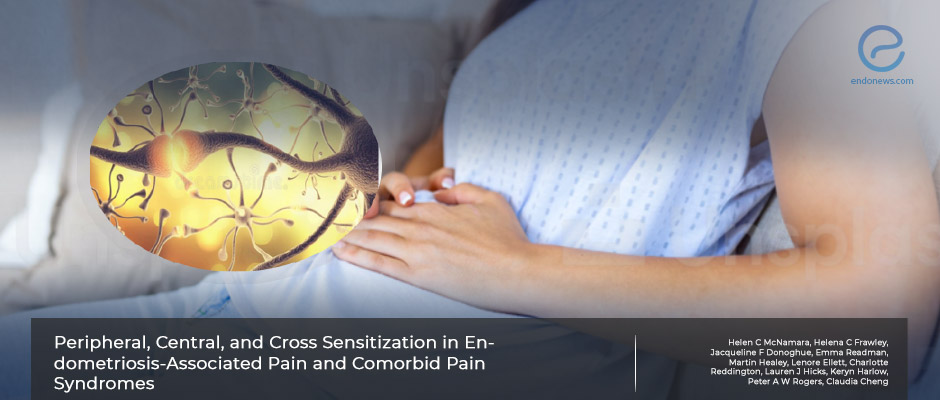Endometriosis-Associated Pain: The Role of Sensitization
Feb 2, 2023
Three different types of sensitization along with comorbid pain syndromes all contribute to the pain endometriosis patients feel
Key Points
Highlight
- To effectively manage endometriosis-associated pain (EAP), it is important for clinicians to understand the multifactorial nature of the pain and address all types of sensitization.
Importance
- EAP is complex and multifactorial that is caused by a combination of local factors, peripheral sensitization, central sensitization, and cross-sensitization.
- The comorbid pain syndromes and the three different sensitization pathways that may be involved should be taken into account when addressing EAP.
What’s done here
- This is a comprehensive mini-review study investigating the mechanisms of pain in endometriosis patients and the associated comorbid pain syndromes.
- Different types of sensitization and comorbid pain syndromes are defined in detail.
Key results
- Local factors that contribute to EAP are alterations in the pelvic nerve fibers' distribution, inflammation, released substances, and neuronal growth.
- "Peripheral sensitization" defines the process where nerve endings in the periphery become more sensitive to pain stimuli.
- The process of the central nervous system becoming more sensitive to pain stimuli and eventually leading to increased perception is called "central sensitization".
- "Cross-sensitization" is the process where the pain in one area leads to increased pain sensitivity in another.
- Comorbid pain syndromes that show similar mechanisms with EAP are bladder pain syndrome, irritable bowel syndrome, vulvodynia, and abdominopelvic myalgia.
Lay Summary
As the most common symptom of the disease, endometriosis-associated pain (EAP) is experienced as dysmenorrhea, non-cyclical pelvic pain, and cyclical pain related to organ function. EAP is contributed to by different mechanisms, including local factors, peripheral sensitization, central sensitization, cross-sensitization, and comorbid persistent pain conditions.
McNamara et al. from Melbourne, Australia wrote a mini-review study that aimed to investigate the mechanisms of pain in women with endometriosis and comorbid pain conditions. The study was published in the September 2021 issue of the journal Frontiers in Reproductive Health.
Persistent pelvic pain is defined as pain in the pelvis that lasts more than 6 months. EAP is defined as persistent pelvic pain in endometriosis patients, where symptoms persist despite treatment and can have emotional and sexual consequences. However, it is stated that definitions of EAP are limited by the current understanding of the condition and may be affected by comorbid pain syndromes.
The mechanism of EAP is multifactorial and the result of an initial local inflammation and heightened sensitivity to pain. This pain can continue due to a combination of peripheral, central, and cross-sensitization, along with psychosocial factors. Local factors include alterations in the pelvic nerve fibers' distribution, inflammation, released substances, and neuronal development.
"Peripheral sensitization" is a process where nerve endings in the periphery (such as the skin or muscles) become more sensitive to pain stimuli. Perineural invasion, changed the sympathetic nervous system, altered peritoneal fluid, and altered nerve density at lesion sites may all be involved in this. "Central sensitization", on the other hand, is a process where the central nervous system becomes more sensitive to pain stimuli, leading to increased pain perception. It may occur as a result of alterations in the hypothalamic-pituitary-adrenal axis. Additionally, "cross-sensitization" is a process where the pain in one area (such as the endometrium) leads to increased pain sensitivity in another area (such as the bladder or bowel).
These different types of sensitization can lead to comorbid pain syndromes, such as bladder pain syndrome, irritable bowel syndrome, vulvodynia, and abdominopelvic myalgia. Treating endometriosis-associated pain should involve addressing all types of sensitization in order to effectively manage pain.
In conclusion, the EAP definition and mechanisms are complex and some have overlapping features with comorbid pain syndromes. The multifactorial aspects of pain that these patients feel should not be overlooked by clinicians taking into account the three different sensitization pathways that may be used in therapy.
Research Source: https://pubmed.ncbi.nlm.nih.gov/36303969/
endometriosis endometriosis-associated pain pain dysmenorrhea sensitization

